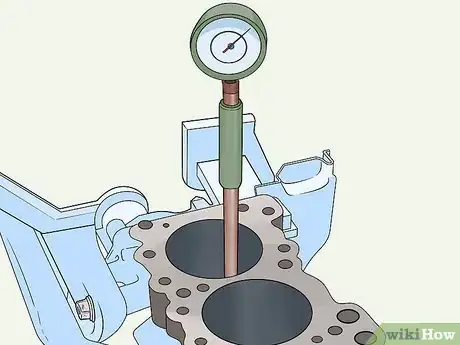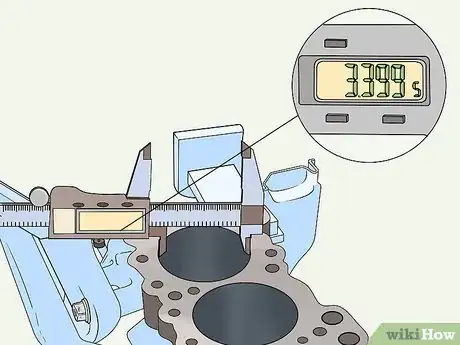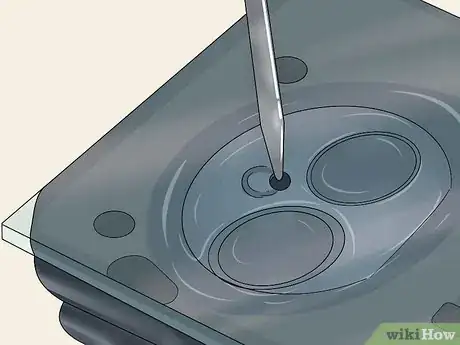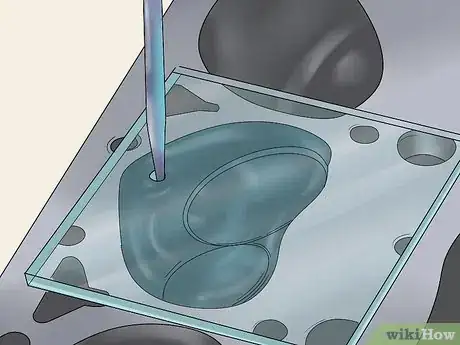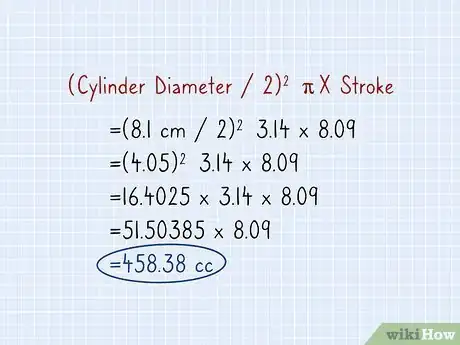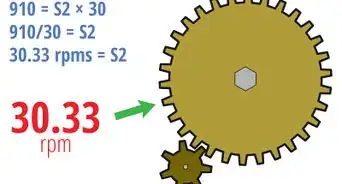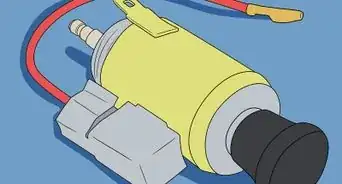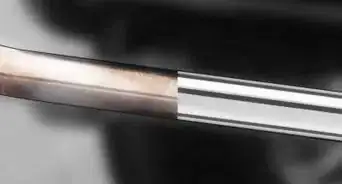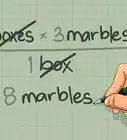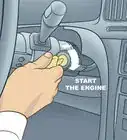This article was co-authored by wikiHow staff writer, Sophia Latorre. Sophia Latorre is a Content Manager on the wikiHow team. Before joining wikiHow, Sophia worked as a technical editor and was published in six International Energy Agency (IEA) Wind Annual Reports. Now, she writes, edits, and reviews articles for the wikiHow Content Team, working to make the content as helpful as possible for readers worldwide. Sophia holds a BA in English from Colorado State University.
There are 10 references cited in this article, which can be found at the bottom of the page.
This article has been viewed 311,913 times.
Learn more...
An engine's compression ratio is essential to know so that you can tune your car to get the most horsepower out of it. To find the compression ratio, divide the total volume of the engine (i.e. the swept volume plus the clearance volume) by the clearance volume of the engine ().[1] Begin with a clean, disassembled engine and take your measurements very carefully to ensure you get an accurate reading.
Steps
Taking Measurements
-
1Measure the bore in centimeters. Use a bore gauge to measure the cylinder bore’s diameter. Remember that the diameter refers to the width of the cylinder. Write this number down so you can refer back to it later.[2]
Tip: Many of the measurements you need are provided in the manufacturer specs. These numbers are more precise than the ones you’d get by measuring by hand, so check the specs first and only measure for the variables not listed.
-
2Find the stroke in centimeters. The stroke refers to how far the piston travels within the cylinder.[3] If you don’t have the specs, measure this using a deck bridge and dial calipers.[4]
- Position the dial calipers on the deck bridge so the jaws are upward. Move the piston to top dead center, then position the bridge over the cylinder. Zero out the calipers, then put the piston at bottom dead center by rotating the crankshaft. Open up the calipers until the depth rod is touching the piston deck, then read the number.
Advertisement -
3Determine the deck height in centimeters. Ensure the piston is at top dead center, then measure between the top of the cylinder and the flat surface at the top of the piston.[5]
- If your piston is above deck, it takes away from the clearance volume. If your piston is below deck, it adds to the clearance volume.[6]
-
4Figure out the piston top volume in cubic centimeters. Use the manufacturer specs for this one or look up the part number online to find the volume.[7] Keep in mind that a piston with a dome takes away from the clearance volume, while a piston with a dish adds to the clearance volume.[8]
- Note that cubic centimeters are abbreviated as cc.
-
5Measure the head gasket volume in cubic centimeters. You may be able to find this information online or in the specs. If not, measure the sealing ring distance in inches and divide that by 3.1416. Square the answer then multiply it by the compressed gasket thickness in thousandths of inches. Take your answer and multiply it by 12.87 to find the head gasket volume in cubic centimeters.[9]
- For example, say the head gasket is 13 inches long and 0.041 inches thick. Divide 13 by 3.1416, which is 4.138. Square this number to get 17.123. Multiply this by 0.041, which is 0.702, then multiply that by 12.87. The head gasket volume is 9.04 cubic centimeters.
-
6Determine the combustion chamber volume in cubic centimeters. Use the specs from the manufacturer to find this measurement. If you need to convert from cubic inches to cubic centimeters, multiply the number by 16.387.[10]
Doing the Calculations
-
1Use the formula (cylinder diameter / 2)2 x π x stroke to find the swept volume. Divide the cylinder diameter by 2. Then, square the result and multiply it by π, which is 3.14. Finally, multiply the result by the stroke to determine the swept volume of the engine.[11]
- For instance, if your cylinder diameter is 8.1 cm and your stroke is 8.9 cm, divide 8.1 by 2, which is 4.05. Square 4.05, which is 16.4025. Multiply this by 3.14, which is 51.50385, then multiply that by 8.09. The answer is 458.38 cc.[12]
Tip: If you don’t want to do the math by hand, search online for a compression ratio calculator.
-
2Find the clearance volume using the formula Vcombustion chamber + Vpiston + Vgasket + Vdeck clearance. Simply add the volume of the combustion chamber, the piston top volume, the gasket thickness, and the deck height or clearance.[13]
- For example, if the volume of the combustion chamber is 38.6, the piston volume is 9.0, the gasket volume is 4.5, and deck clearance is 1.6, the clearance volume is 53.7 cc.
-
3Plug your numbers into the formula CR = (Vsw + Vcl) / Vcl. Now that you know the swept volume and clearance volume, simply insert those numbers into the formula and solve it. Add the swept volume and cylinder volume together first. Then, divide the result by the cylinder volume to find the compression ratio.[14]
- For instance, if the swept volume is 458.38 and the clearance volume is 53.7, start by adding 458.38 and 53.7, which is 512.08. Divide 512.08 by 53.7, which is 9.5359. So, the compression ratio is 9.54:1.
Community Q&A
-
QuestionHow do I convert cubic centimeters to horsepower?
 Community AnswerYou cannot. There is really no relationship between cubic centimeters and horsepower. While bigger engines tend to have more power, there are a lot more factors contributing to power output. You could have a 100cc engine with the same amount of power as a 50cc engine because of the other factors.
Community AnswerYou cannot. There is really no relationship between cubic centimeters and horsepower. While bigger engines tend to have more power, there are a lot more factors contributing to power output. You could have a 100cc engine with the same amount of power as a 50cc engine because of the other factors. -
QuestionHow do I calculate engine capacity?
 ali mokhtariCommunity AnswerFirst, measure the cylinder bore and then its height. The engine volume is as follows: number of engine cylinders x 3.1415 x (cylinder bore)^2. Another method is to inverse the cylinder block on a flat metal surface and use a graduated container to fill the cylinder space with a liquid (as you keep track of the amount of liquid you pour inside) until all engine cylinders are full. The volume of liquid required to fill up all engine cylinders amounts for engine capacity.
ali mokhtariCommunity AnswerFirst, measure the cylinder bore and then its height. The engine volume is as follows: number of engine cylinders x 3.1415 x (cylinder bore)^2. Another method is to inverse the cylinder block on a flat metal surface and use a graduated container to fill the cylinder space with a liquid (as you keep track of the amount of liquid you pour inside) until all engine cylinders are full. The volume of liquid required to fill up all engine cylinders amounts for engine capacity. -
QuestionWhat is the compression ratio for petrol engines?
 Community AnswerDiesel engines are designed to operate at higher compression ratios (usually between 15 to 20), while petrol engines have lower compression ratios (usually between 8 to 10).
Community AnswerDiesel engines are designed to operate at higher compression ratios (usually between 15 to 20), while petrol engines have lower compression ratios (usually between 8 to 10).
Warnings
- Take proper precautions when working on your car's engine. Make sure that the engine parts are cool before beginning and wear protective gear such as safety glasses, close-toed shoes, and gloves.⧼thumbs_response⧽
Things You'll Need
- Manufacturer specs
- Measuring tape
- Paper
- Pencil
- Bore gauge
- Deck bridge
- Dial calipers
- Calculator
References
- ↑ https://youtu.be/i9io_DknQ3U?t=14
- ↑ https://www.rbracing-rsr.com/compstaticcalc.html
- ↑ https://www.rbracing-rsr.com/compstaticcalc.html
- ↑ https://help.summitracing.com/app/answers/detail/a_id/5001/~/engine-stroke-length
- ↑ https://www.rbracing-rsr.com/compstaticcalc.html
- ↑ https://youtu.be/i9io_DknQ3U?t=168
- ↑ https://www.rbracing-rsr.com/compstaticcalc.html
- ↑ https://youtu.be/i9io_DknQ3U?t=160
- ↑ http://www.eatonbalancing.com/2012/06/30/head-gasket-volume-calculation/

